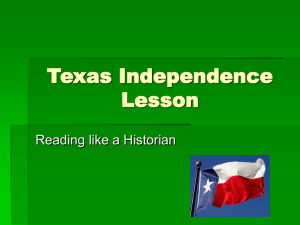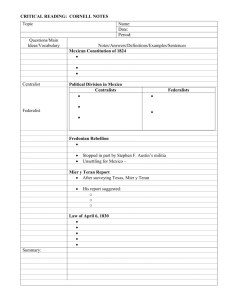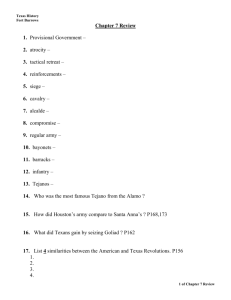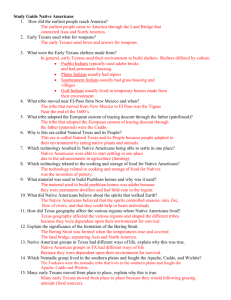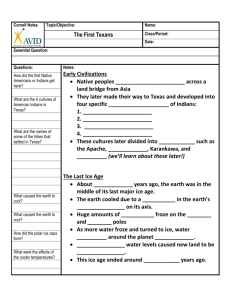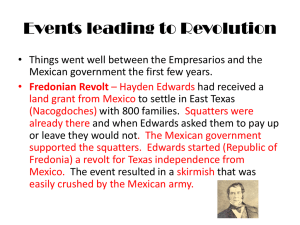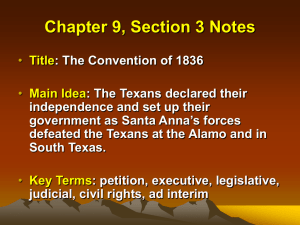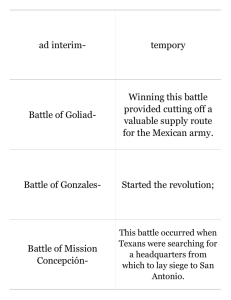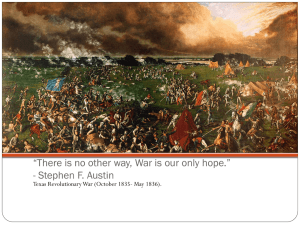Names of battles and their outcomes on the way to victory.
advertisement
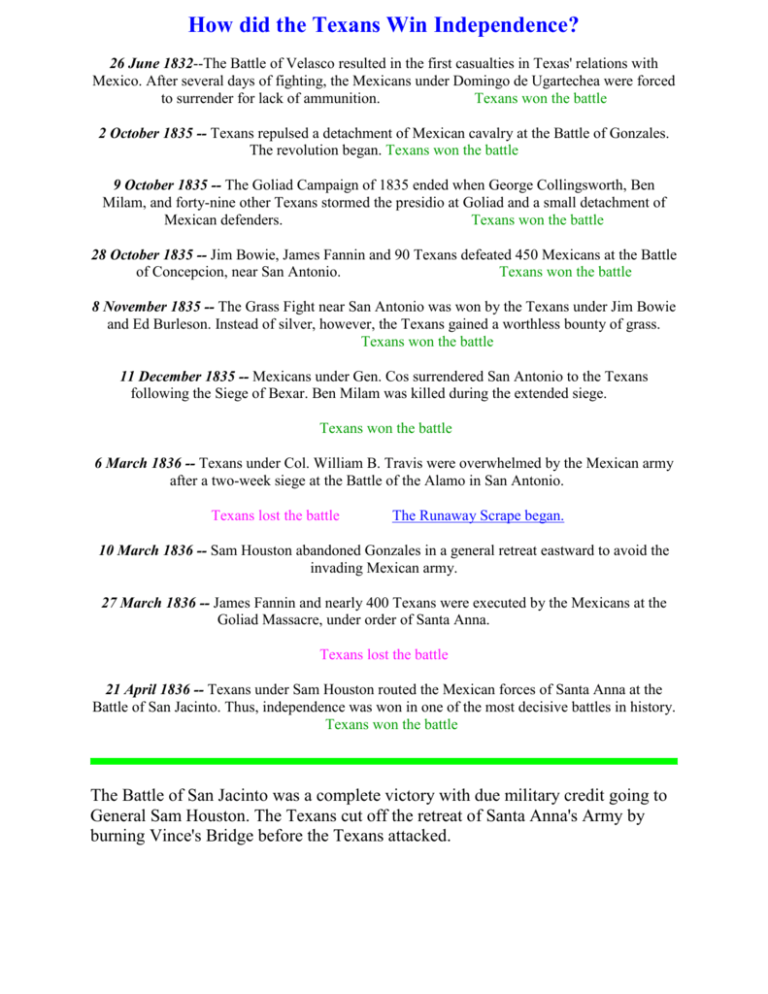
How did the Texans Win Independence? 26 June 1832--The Battle of Velasco resulted in the first casualties in Texas' relations with Mexico. After several days of fighting, the Mexicans under Domingo de Ugartechea were forced to surrender for lack of ammunition. Texans won the battle 2 October 1835 -- Texans repulsed a detachment of Mexican cavalry at the Battle of Gonzales. The revolution began. Texans won the battle 9 October 1835 -- The Goliad Campaign of 1835 ended when George Collingsworth, Ben Milam, and forty-nine other Texans stormed the presidio at Goliad and a small detachment of Mexican defenders. Texans won the battle 28 October 1835 -- Jim Bowie, James Fannin and 90 Texans defeated 450 Mexicans at the Battle of Concepcion, near San Antonio. Texans won the battle 8 November 1835 -- The Grass Fight near San Antonio was won by the Texans under Jim Bowie and Ed Burleson. Instead of silver, however, the Texans gained a worthless bounty of grass. Texans won the battle 11 December 1835 -- Mexicans under Gen. Cos surrendered San Antonio to the Texans following the Siege of Bexar. Ben Milam was killed during the extended siege. Texans won the battle 6 March 1836 -- Texans under Col. William B. Travis were overwhelmed by the Mexican army after a two-week siege at the Battle of the Alamo in San Antonio. Texans lost the battle The Runaway Scrape began. 10 March 1836 -- Sam Houston abandoned Gonzales in a general retreat eastward to avoid the invading Mexican army. 27 March 1836 -- James Fannin and nearly 400 Texans were executed by the Mexicans at the Goliad Massacre, under order of Santa Anna. Texans lost the battle 21 April 1836 -- Texans under Sam Houston routed the Mexican forces of Santa Anna at the Battle of San Jacinto. Thus, independence was won in one of the most decisive battles in history. Texans won the battle The Battle of San Jacinto was a complete victory with due military credit going to General Sam Houston. The Texans cut off the retreat of Santa Anna's Army by burning Vince's Bridge before the Texans attacked. The attack was a total surprise to the Mexican Army. They were taking a siesta at two o'clock in the afternoon. Their weapons were stacked tee pee style, they had not posted any guards or sentries. Just the lack of concern at the time of their nap is probably the largest single factor in the outcome of the battle. Many say Santa Anna was chasing General Sam Houston, but obviously Santa Anna did not know where the Texans were. The buffalo grass was shoulder high, so the Texas scouts were concealed when spying on the Mexicans. The year of 1836 was very wet in Texas, and an important factor in the defeat of the Mexicans was the weather. Without Vince's bridge the escaping Mexicans were forced to scale the steep soft wet banks of the bayou on foot because a horse couldn't climb them. What were Santa Anna and his army chasing? The lack of sentries or guards is damning evidence that it was not Sam Houston. There were other fleeing Texans in the area that participated in the Runaway Scrape. I have not found written evidence where the Texas rebels vice president, Lorenzo de Zavala, or their cabinet were during the month of April 1836, but it is likely Santa Anna may have known and was chasing them. Where, in Texas, were the rest of the six thousand men of the Mexican Army? April 14, 1836 Santa Anna crossed the Brazos River at Fort Bend [now Richmond] with thirteen hundred elite, well equipped, handpicked men and went east to the Battle of San Jacinto. He left behind, at Fort Bend, his second in command, General Vicient Filisola, to lead the remaining fourteen hundred men. As many as two thirds of the rifles left behind would not fire. Santa Anna did not take wounded, sick or prisners with him. Filisola had 87 mounted soldiers, but the condition of the horses was pitiful due to the long distance traveled and slight feed available while chasing Sam Houston. There was another Mexican army under the command of General Jose' Urrea, that had come up the coast capturing Matagorda, Columbia and Brazoria. General Urrea wanted to capture Velasco and proceed to Galveston but was notified of Santa Anna's 'unfortunate situation' while still in Brazoria. Urrea marched north to Powell Point while Filisola marched south to Powell Point. Both armies were at Powell Point on April 24, 1836. Powell Point is on Turkey Creek in southern Fort Bend County east of the towns of Kendleton and Beasley. On April 25 the combined army moved west, crossed the San Bernard river and made camp on April 26. There was a constant rain all day. Scouts returned from the West Bernard with news it was obvious they could not cross it because of flood. They could not re-cross the San Bernard because of flood so the army marched upstream between the two streams in a north westerly direction. This section of land holds water and the soil becomes very soft with a soft footing at 3 to 5 feet deep when wet. This area extends to the north of the town of East Bernard and west to the town of Eagle Lake. Today it is a vast area of rice farms. It took three weeks for the twenty five hundred men with equipment to slosh through the quagmire and it rained most of the time. On May 14, 1836 the army was a league away from the Colorado river. General Filisola called this 'The Sea of Mud'. Three weeks is a long time to wait to begin a counter attack on the Texans. There were encounters with some Texans during this time so the Texans knew where the Mexican Army was. What was worse was the Mexican Army was exhausted with their equipment in dis-repair or lost. This army was defeated by bad luck and weather conditions without a battle with the Texans. Suggested Reading Sea of Mud By Gregg D. Demmick Texas State Historical Association
